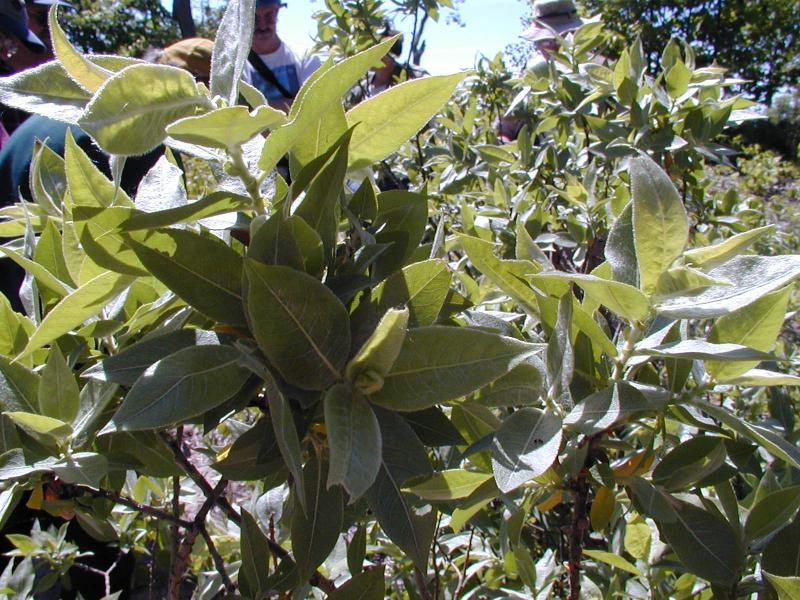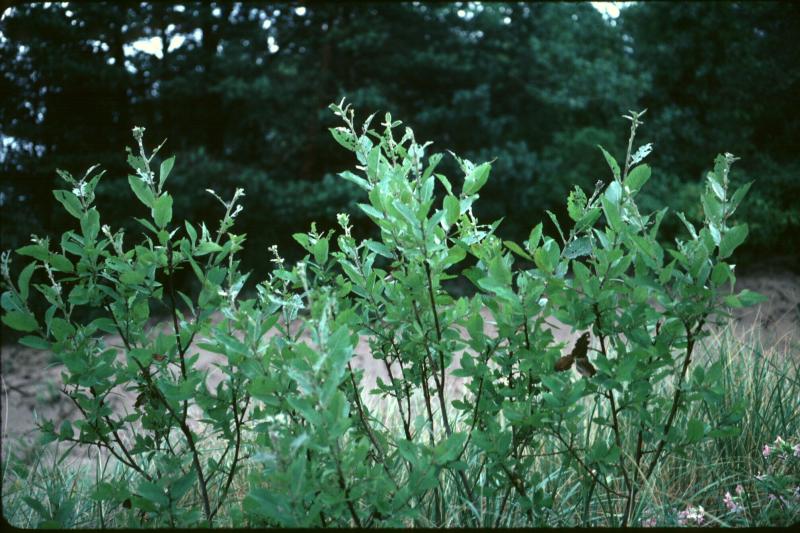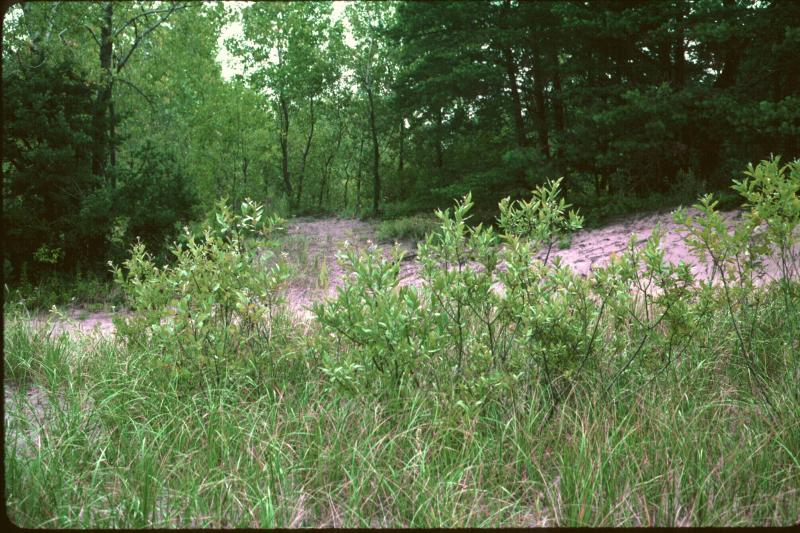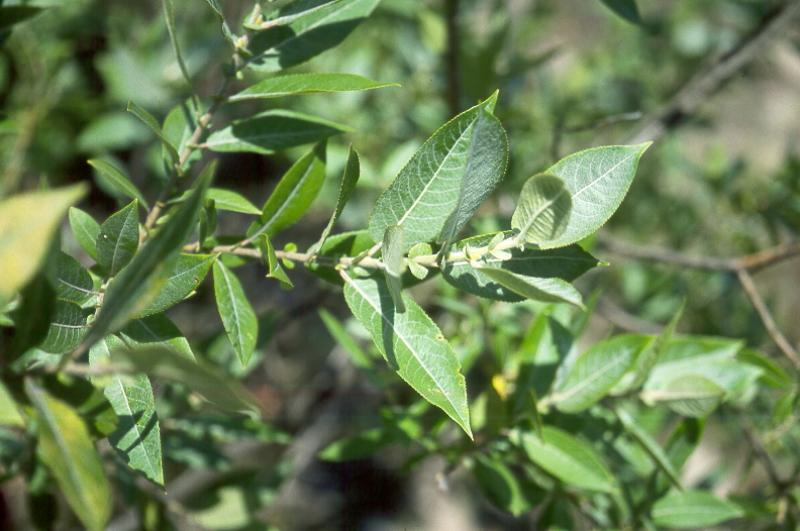Sand Dune Willow
Salix cordata Michx.
- Class
- Dicotyledoneae (Dicots)
- Family
- Salicaceae (Willow Family)
- State Protection
- Threatened
Listed as Threatened by New York State: likely to become Endangered in the foreseeable future. For animals, taking, importation, transportation, or possession is prohibited, except under license or permit. For plants, removal or damage without the consent of the landowner is prohibited.
- Federal Protection
- Not Listed
- State Conservation Status Rank
- S2
Imperiled in New York - Very vulnerable to disappearing from New York due to rarity or other factors; typically 6 to 20 populations or locations in New York, very few individuals, very restricted range, few remaining acres (or miles of stream), and/or steep declines.
- Global Conservation Status Rank
- G4
Apparently Secure globally - Uncommon in the world but not rare; usually widespread, but may be rare in some parts of its range; possibly some cause for long-term concern due to declines or other factors.
Summary
Did you know?
Mature sand dune willow is limited to a narrow ecological zone on the dune where there is continuous sunlight and sand with little organic content. A flea beetle, Altica subplicata, feeds on its leaves and directly decreases the growth and increases mortality of the plant.
State Ranking Justification
There are seven known populations within a very limited range and habitat. Few to no new populations are expected since the areas of potential habitat have been well surveyed. There are minimal threats that include development and recreation activities, but many of the populations are within protected landscapes.
Short-term Trends
There are seven populations of this plant and no more are expected. The populations seem to be doing well and little change is expected in the foreseeable future.
Long-term Trends
This plant was only ever known in its present location and the populations have only seen small fluctuations for many years.
Conservation and Management
Threats
There may be some problems with off road vehicles damaging plants but it is probably not severe. Cessation of dune building processes may also be a problem but more research needs to be done.
Conservation Strategies and Management Practices
Populations need to be monitored for damage from off road vehicles.
Research Needs
Research needs to be done into how changes in dune building processes are affecting these plants. Research could also be done into propagation of plants.
Habitat
Habitat
A shrub restricted to the sand beaches and dunes along the eastern shore of Lake Ontario (New York Natural Heritage Program 2002). Sandy and alluvial shores (Gleason and Cronquist 1991). Almost completely restricted, in Michigan, to sandy shores and dunes along the Great Lakes (Voss 1985). Sand dunes; river banks and lake shores in sandy, silty or gravelly soils (Soper 1982). Dunes and beaches of the Great Lakes, gravelly or sandy shores (Fernald 1970).
Associated Ecological Communities
- Great Lakes dunes
(guide)
A community dominated by grasses and shrubs that occurs on active and stabilized sand dunes along the shores of the Great Lakes. Unstable dunes are sparsely vegetated, whereas the vegetation of stable dunes is more dense, and can eventually become forested.
- Sand beach
A sparsely vegetated community that occurs on unstable sandy shores of large freshwater lakes, where the shore is formed and continually modified by wave action and wind erosion. Characteristic species that are usually present at very low percent cover include various grasses and other herbs.
Associated Species
- Ammophila breviligulata (beach grass)
- Ammophila champlainensis
- Artemisia campestris ssp. caudata (sand wormwood)
- Cornus sericea (red-osier dogwood)
- Populus deltoides
- Prunus pumila var. pumila (Great Lakes sand cherry)
- Sporobolus cryptandrus (sand dropseed)
- Toxicodendron radicans ssp. radicans (eastern poison-ivy)
- Vitis riparia (river grape, frost grape)
Range
New York State Distribution
This shrub is limited to the dunes and beaches along Lake Ontario.
Global Distribution
This shrub can be found along shorelines and dune systems from Newfoundland, eastern Quebec, Nova Scotia, to northern Maine, and westward around the Great Lakes to Illinois, Wisconsin, and northern Michigan, and northward to the Hudson Bay.
Identification Comments
General Description
Sand dune willow grows as scattered shrubs 3-12 feet high but shrubs taller than 6 feet are rare. The small-diameter stems, subjected to constant winds, arch upward from the base. The twigs are covered with white to grayish matted hairs that fall off with age to reveal a smooth, dark reddish bark. The leaves grow at the tops of the stems and are covered with white hairs when young but they become a more lustrous green above as they mature. They are lance-shaped, 3-10 cm long, with pointed, sometimes long-pointed, tips and broad, rounded bases. The edges are toothed with little glands on the teeth. The veins are prominent on the lower surface. The stipules at the base of the stout petiole are large, obvious and heart-shaped. The catkins emerge with the leaves and are 5-8 cm long. The scales are brown and covered with dense long hairs. The fruit capsules are smooth and arranged horizontally when mature.
Identifying Characteristics
This shrubby Salix is limited to the dune systems of Lake Ontario in New York. The branchlets are stout, reddish, and covered with dense white to grayish tomentum when young. The older branches are often smooth. The leaves are densely lustrous-hairy and sometimes red-tinged when young. The blades of mature leaves are 3-10 cm long, 1-5 cm wide, thickish, and either ovate-lanceolate, lance-oblong, oblong-ovate or broadly ovate. The leaf apex is acute or abruptly acuminate. The leaf margins are glandular-dentate-serrate. The veins are prominent on the lower surface. The leaf base is cordate or broadly rounded. The petiole is stout, 2-10 mm long, and pubescent. The stipules are large, 6-15 mm long, obliquely ovate or semi-cordate, and glandular dentate on the longer margin. The stamens are exserted beyond the long-hairy, dark brown to black scales. The ovaries are glabrous, in anthesis appressed-ascending, in fruit more spreading, and on pedicels shorter than bracts. The capsules are divergent or horizontally spreading when mature.
Best Life Stage for Proper Identification
Having plants with leaves and flowers or fruits is best, but people familiar with this plant should be able to identify it vegetatively.
Similar Species
Salix rigida has mature blades that are one sixth to one third as broad as long. Salix eriocephala has leaves that are dark green above, glaucous beneath, narrower. No other willow has the same leaf length to width ratio and broad leaf base as Salix cordata.
Best Time to See
This shrub flowers May through June and is in fruit late June through July. Due to its specific habitat and unique leaf shape, surveys may be conducted at any point during the growing season.
- Vegetative
- Flowering
- Fruiting
The time of year you would expect to find Sand Dune Willow vegetative, flowering, and fruiting in New York.
Sand Dune Willow Images
Taxonomy
Sand Dune Willow
Salix cordata Michx.
- Kingdom Plantae
- Phylum Anthophyta
- Class Dicotyledoneae
(Dicots)
- Order Salicales
- Family Salicaceae (Willow Family)
- Order Salicales
- Class Dicotyledoneae
(Dicots)
- Phylum Anthophyta
Additional Common Names
- Furry Willow
- Heartleaf Willow
- Sand-dune Willow
Synonyms
- Salix syrticola Fern.
Additional Resources
Best Identification Reference
Gleason, Henry A. and A. Cronquist. 1991. Manual of Vascular Plants of Northeastern United States and Adjacent Canada. The New York Botanical Garden, Bronx, New York. 910 pp.
Other References
Bach, Catherine E. 1994. Effects of a Specialist Herbivore (Altica subplicata) on Salix cordata and Sand Dune Succession. Ecological Monographs 64(4): 423-445.
Fernald, M.L. 1950. Gray's manual of botany. 8th edition. D. Van Nostrand, New York. 1632 pp.
Holmgren, Noel. 1998. The Illustrated Companion to Gleason and Cronquist's Manual. Illustrations of the Vascular Plants of Northeastern United States and Adjacent Canada. The New York Botanical Garden, Bronx, New York.
New York Natural Heritage Program. 2024. New York Natural Heritage Program Databases. Albany, NY.
Reschke, Carol. 1990. Ecological communities of New York State. New York Natural Heritage Program, New York State Department of Environmental Conservation. Latham, NY. 96 pp. plus xi.
Silkey, Douglas. 1989. A Survey of Sand Cherry (Prunus pumila) and Dune Willow (Salix cordata) at El Dorado Shores Preserve; Jefferson County, New York State. A Research Paper for Problems in Biology, Donald Leopold Advisor, State University of New York College of Environmental Science and Forestry, Syracuse, NY.
Soper, James H. and Margaret L. Heimburger. 1982. Shrubs of Ontario. The Royal Ontario Museum, Toronto, Canada, 495P.
Voss, E.G. 1985. Michigan Flora. Part II. Dicots (Saururaceae - Cornaceae). Cranbrook Institute of Science and University of Michigan Herbarium. Ann Arbor, Michigan. 724 pp.
Weldy, T. and D. Werier. 2010. New York flora atlas. [S.M. Landry, K.N. Campbell, and L.D. Mabe (original application development), Florida Center for Community Design and Research http://www.fccdr.usf.edu/. University of South Florida http://www.usf.edu/]. New York Flora Association http://newyork.plantatlas.usf.edu/, Albany, New York
Links
About This Guide
Information for this guide was last updated on: January 15, 2009
Please cite this page as:
New York Natural Heritage Program. 2024.
Online Conservation Guide for
Salix cordata.
Available from: https://guides.nynhp.org/sand-dune-willow/.
Accessed July 27, 2024.



